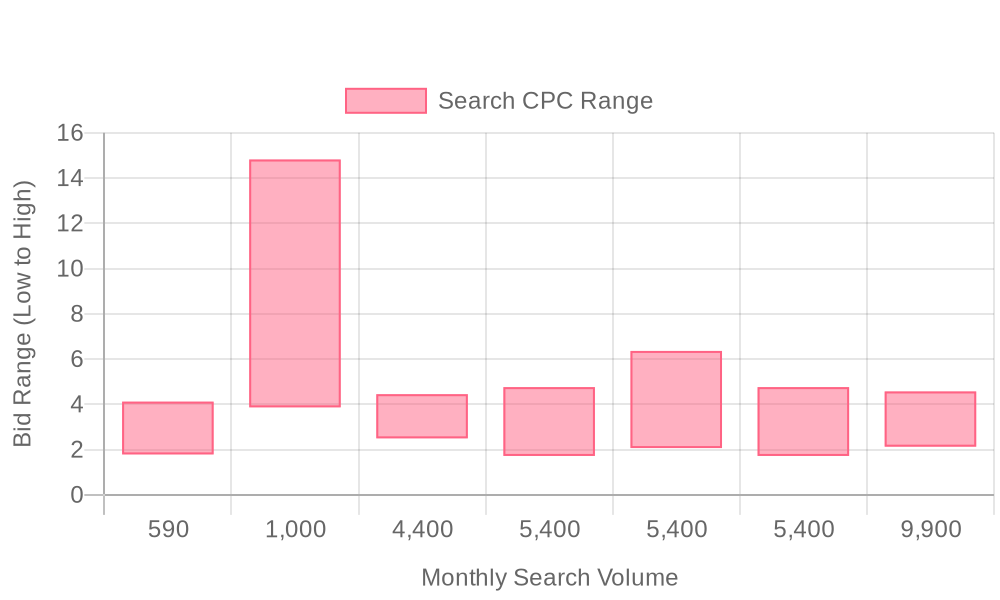
Supercharge your lead generation with a FREE Google Ads audit - no strings attached! See how you can generate more and higher quality leads
Get My Free Google Ads AuditFree consultation

No commitment
Supercharge your lead generation with a FREE Google Ads audit - no strings attached! See how you can generate more and higher quality leads
Get My Free Google Ads AuditFree consultation

No commitment
In today's rapidly evolving digital marketing landscape, defense contractors face unique challenges in reaching their niche audience. The sophistication required to communicate effectively with decision-makers in the defense sector means using platforms where these stakeholders are actively searching for solutions. Google Ads is a powerful tool that can bridge the gap between awareness and acquisition by intercepting potential leads at their moment of intent. By using targeted ad placements, defense contractors can engage with prospects through precision targeting and data analysis, making Google Ads an indispensable part of a robust marketing strategy.

Defense contractors operate in a landscape where every qualified lead can produce transformative business impact, yet traditional outreach often fails to engage the right government and military stakeholders. A precise, data-driven Google Ads strategy puts your solutions at the center of procurement research and active contract searches, ensuring your message appears to decision-makers at critical moments in the buying cycle. For an overview of strategies tailored specifically for this sector, see this marketing strategies for defense contractors resource.
Integrating Google Ads into a defense contractor’s marketing mix unlocks tailored targeting, scalable outreach, and measurable growth. With advanced identification tools, marketers can now move beyond anonymous web traffic and attribute ad engagement to specific companies and individuals, optimizing campaign investment toward genuine high-value prospects.
For defense contractors, paid search isn’t just about generating website clicks; it is about capturing intent from procurement teams, technical evaluators, and acquisition officers searching for certified, compliant vendors. Success begins with robust keyword research that reflects not only defense-industry products and services but also integrates phrases tied to certifications, contract vehicles, and government standards. For step-by-step guidance on implementing these solutions, explore this digital marketing guide for government contractors.
Continuous data analysis is essential. Instead of relying on broad metrics, advanced lead identification platforms enable marketers to tie traffic and conversions to specific companies and government agencies, uncovering which accounts are actively researching contract-relevant solutions. This granular insight allows for budget reallocation in real time, focusing spend on higher-converting accounts and deprioritizing low-value traffic. As a result, campaign ROI improves, and the sales team gains actionable intelligence on which prospects are most likely to move forward in the procurement process.

Audience targeting for the defense sector is fundamentally different from commercial B2B. Contractors need to segment campaigns around role-based personas—procurement officials, program managers, technical evaluators—each with their own intent signals and buying criteria. Using Google Ads’ custom audiences and in-market segments, marketers can zero in on specific government agencies, defense contractors, and industry primes. For a deeper dive into building real-time audience segments and syncing them with ad platforms, explore how dynamic segmentation empowers more precise targeting.
Keyword strategy should prioritize long-tail, compliance-driven phrases that mirror the language used in RFPs and government procurement solicitations. By dynamically updating audience lists as prospects move through the research and consideration stages, campaigns maintain relevance and high engagement. When integrated with platforms that sync audience data into CRMs, defense marketers can ensure that each new opportunity is nurtured with timely, personalized messaging, streamlining the path from initial click to qualified lead.

Effective ad creative in the defense industry requires a blend of clear compliance messaging, technical specificity, and tangible proof points. Ads that highlight credentials such as CMMC certification, past contract awards, or GSA schedule listings immediately establish trust and credibility with government audiences. For guidance on compliance and security, review how Google Workspace supports CMMC 2.0 compliance.
Optimized creative is not static. By monitoring which messages, formats, and value propositions drive the highest conversion rates, marketers can continuously refine ad copy and design. Integrations that track visitor engagement beyond clicks help defense contractors pinpoint which creative assets drive true pipeline growth, not just web traffic.

Sustained campaign performance in defense contractor marketing relies on a closed feedback loop between ad platforms, analytics, and CRM systems. Automated rules and smart bidding, informed by real-time intent signals, ensure that budgets adapt to the shifting priorities and buying cycles of defense agencies. For a look at how AI and automation are transforming ad account management, see this report on Google’s AI-powered defense.
Performance optimization is accelerated by syncing enriched prospect data—firmographic, behavioral, and intent—directly into campaign audiences. As pipeline opportunities mature or new decision-makers emerge, audience segments are dynamically updated, keeping ad messaging relevant and maximizing conversion potential throughout the lengthy government procurement process.
Google Ads for defense contractors operates most effectively as part of a unified, multi-channel demand generation strategy. Integrations with platforms that sync audience and engagement data into CRM, marketing automation, and sales enablement systems enable seamless handoff from marketing to business development. For additional tactics on lead generation in defense, check out this lead generation guide for defense.
This level of orchestration ensures that every touchpoint—whether advertising to government agencies, engaging at industry events, or following up via email—leverages the same up-to-date account insights and engagement history. Ultimately, this unified approach drives higher conversion rates, shorter sales cycles, and more predictable revenue growth for defense contractors navigating the complexities of government acquisition. If you’re ready to activate data-driven lead generation, get started for free with Sona and see how seamlessly these integrations can drive your results.
Defense contractors operate within a tightly regulated and highly specialized environment where every marketing move must be deliberate and data-driven. Google Ads offers a direct line to decision-makers at the exact moment they search for solutions, enabling contractors to bypass lengthy sales cycles and surface their expertise when it matters most. For an overview of proven marketing strategies in the sector, see this defense contractor marketing guide.
To see how you can accelerate and measure your defense marketing impact, get started for free with Sona.

Digital marketing for defense contractors requires precision and speed. Delayed follow-ups or generic targeting result in missed opportunities, especially when decision-makers in procurement move quickly through vendor lists. Advanced targeting strategies ensure that high-value leads remain engaged throughout the government contractor advertising funnel.
Ready to modernize your defense marketing funnel? Get started for free with Sona.
Defense contractors face a unique digital landscape where the right growth opportunities can be both lucrative and difficult to spot. Identifying untapped market segments, synchronizing outreach with procurement cycles, and leveraging data-driven intent signals are all critical for driving measurable results in government contractor advertising. For an overview of specialized marketing strategies tailored for this sector, explore defense contractor marketing solutions.
In today’s B2B buying environment, unifying intent data, audience attributes, and conversion analytics is the foundation for scalable growth in PPC for defense contractors. To consistently identify, capture, and convert high-value government opportunities in an increasingly competitive digital landscape, get started for free with Sona.
Defense contractors operate in a landscape where every marketing dollar must directly support pipeline growth and contract acquisition. Audience segmentation, when executed with precision, helps teams avoid wasted spend on low-fit accounts and enables more targeted, relevant outreach throughout the customer journey. For an overview of effective marketing strategies and services tailored for defense and government contractors, review this defense and government contractor marketing guide.
To build high-performing segments, start by defining clear distinctions between core audiences such as military versus civilian buyers or those in aerospace compared to manufacturing verticals. This specificity allows marketing teams to tune their messaging, creative, and offers to the unique needs and regulations facing each segment. Overlaying intent signals—such as recent engagement with procurement-related content or activity during key defense budgeting cycles—enables teams to prioritize accounts that are actively researching solutions or nearing purchase decisions. By capturing in-market behaviors, marketers dynamically shift budget and messaging toward those most likely to convert, ensuring resources support the highest-value leads first.
Customizing ad groups with segment-specific messaging and tailored budgets ensures each campaign speaks directly to the audience’s priorities. For example, messaging for a military-focused segment can emphasize compliance, mission readiness, and secure supply chain credentials, while civilian or manufacturing prospects may respond to themes of operational efficiency and cost savings. Segment-based budget allocation also refines spend, directing more investment to high-potential verticals based on real-time performance data and account movement through the funnel. As leads engage, advanced visitor identification capabilities allow marketers to go beyond anonymous web traffic, pinpointing organizations and stakeholders showing high intent for defense-specific solutions.
True audience segmentation extends beyond Google Ads: integrating with a CRM creates a seamless conversion path, aligning sales and marketing around a unified view of the buyer journey. CRM integration allows enriched audience data and fit scoring to sync instantly across Google Ads, HubSpot, Salesforce, and more, keeping campaigns aligned with shifting qualification criteria and opportunity stages. As prospects interact with ads or website content, dynamic audience updates ensure retargeting and nurture flows are always relevant to the prospect’s current needs and buying stage. This unified data approach not only eliminates manual data silos but also drives higher conversion rates by enabling precise, personalized follow-up—essential for winning complex defense contracts. Get started for free with Sona.

| Industry | Keyword | Monthly Search Volume | Competition Level | Low Bid | High Bid |
| Defense Contractors | military contracting companies | 590 | LOW | 1.79 | 4.12 |
| Defense Contractors | army contractor | 1000 | LOW | 3.87 | 14.82 |
| Defense Contractors | defense companies | 4400 | LOW | 2.5 | 4.45 |
| Defense Contractors | military contractors | 5400 | LOW | 1.72 | 4.76 |
| Defense Contractors | dod contracts | 5400 | LOW | 2.07 | 6.36 |
| Defense Contractors | military contractor | 5400 | LOW | 1.72 | 4.76 |
| Defense Contractors | defense contractors | 9900 | LOW | 2.13 | 4.57 |
Adopting a nuanced keyword strategy is fundamental for any PPC initiative targeting the defense contractor sector. Success hinges on intercepting B2B decision-makers at the exact moment they research solutions, prioritize compliance, or evaluate qualified vendors. Disconnected data and rigid keyword lists often lead to missed opportunities, but leveraging integrated insights enables marketers to capture high-value demand without overspending on irrelevant clicks.
Unified campaign data empowers marketers to uncover not just what audiences search for, but also how those searches shift based on purchase signals. By syncing CRM and ad data, enriched audiences and qualified leads flow directly into Google Ads and revenue platforms, creating a closed feedback loop. This ensures that as prospects engage with compliance documentation or fill out demo requests, keyword strategies automatically update and future targeting reflects the most current intent signals. The result is a continuously optimized keyword portfolio that intercepts every relevant opportunity across the defense procurement landscape. To experience how seamless keyword and data integration can transform your campaigns, get started for free with Sona.
Launching high-performance Google Ads campaigns in the defense sector requires a disciplined, data-centric approach. B2B marketers in this space need more than broad targeting: they must address technical procurement cycles, stringent compliance, and the precise pain points of government buyers. For a deeper dive into marketing approaches tailored for this industry, explore marketing strategies for defense contractors.
Slow campaign feedback and disjointed data handoffs often stall optimizations. A unified, real-time data pipeline enables defense contractors to react instantly to market signals, accelerating campaign improvements and ensuring ad spend stays focused on accounts showing true purchase intent. Teams looking to activate seamless, real-time data flows can leverage Sona’s Destinations to keep CRM and ad platforms always in sync.
Developing effective keyword lists for PPC in the defense industry starts with clustering around core service offerings, such as compliance consulting, secure communications, or supply chain logistics. By segmenting keywords by service type as well as layering on geographic modifiers—like "CMMC compliance Texas" or "secure cloud solutions Virginia"—contractors can hone in on federal and state agency decision-makers relevant to their expertise. For guidance on digital marketing solutions that help government contractors win more bids, see digital marketing for government contractors.
Marketers move beyond guesswork by integrating real-time visitor identification, allowing them to pinpoint not just which organizations are searching for specific services but also their readiness to buy. This actionable insight lets teams prioritize high-value keywords and rapidly test new clusters as procurement trends shift, keeping campaigns tightly synced with evolving government demand.
Effective ad copy in defense contractor marketing must directly address the unique pain points of procurement officers and technical evaluators. Messaging that highlights certifications, compliance standards, and past contract performance builds immediate trust, while referencing agency-specific language—such as "ITAR registered" or "FedRAMP authorized"—dramatically boosts relevance. For a comprehensive look at successful B2B ad campaigns, review these B2B Google Ads campaign strategies.
With dynamic audience segmentation, marketers can tailor headlines and descriptions to match the research stage or urgency of each account. As leads progress, creative can automatically update to emphasize value props most likely to convert: from technical whitepapers for early-stage prospects to procurement templates for buyers nearing decision. This level of personalization ensures messaging resonates at every touchpoint, increasing engagement and qualification rates.
High-converting landing pages for the defense sector must tightly align with each ad group, featuring messaging and content that mirror the searcher’s specific needs. Pages should prominently display trust signals—such as third-party certifications, contract vehicles, and secure data handling policies—to immediately address procurement concerns. Explore a real-world Google Ads case study for actionable insights on landing page optimization and campaign improvement.
Integrating advanced attribution and CRM syncing, marketers can identify which agency visitors interact with landing pages, how deeply they engage, and at what stage they drop off. These insights allow for rapid A/B testing and continuous refinement, ensuring every page element—from form fields to call-to-action copy—is engineered for maximum conversion, particularly among high-value, government-focused accounts.
Ongoing optimization is essential for digital marketing in the defense industry. Leveraging analytics and smart bidding, marketers can quickly identify which keyword clusters or creative variants are generating qualified leads versus wasting budget. Automated rules and machine learning models further refine bidding strategies, shifting spend toward campaigns with the highest likelihood of conversion and contract value. For industry insights on AI-powered ad defense and fraud prevention, see Google’s AI-powered defense.
As leads engage, real-time data syncs between CRM and ad platforms ensure audience lists and retargeting segments reflect the latest buying signals. This dynamic approach means high-intent accounts receive tailored follow-ups, while cold prospects are deprioritized, maximizing the ROI of every dollar spent and providing a closed-loop system for measuring true pipeline impact. To experience this level of campaign control, get started for free with Sona.
Defense contractors who excel in digital marketing strategies consistently outperform their peers in lead generation, contract acquisition, and brand visibility within government procurement cycles. By leveraging targeted Google Ads campaigns and integrating real-time marketing intelligence, these organizations secure a measurable edge in a highly competitive, compliance-driven sector. For a comprehensive look at marketing strategies tailored for defense and government contractors, explore this overview of industry best practices.
Integrating educational materials into retargeting strategies is an effective way to engage defense sector decision-makers who are in various stages of the procurement process. When retargeting site visitors interested in compliance resources or technical documentation, deliver value-driven content such as white papers, procurement checklists, or guides tailored to government standards. Leveraging visitor identification and intent data allows marketers to prioritize high-value accounts, ensuring these educational touchpoints reach the right stakeholders at the right time.
Upsell techniques aligned with CRM data are crucial for capturing the multifaceted needs of defense organizations. By syncing CRM insights with Google Ads audiences, you can target existing clients with new offerings—such as emerging cybersecurity solutions or logistics enhancements—precisely when their contract renewal or expansion windows approach. Dynamic audience updates ensure messaging and offers remain relevant, increasing cross-sell and upsell rates. For actionable strategies on optimizing Google Ads campaigns for B2B growth, review this comprehensive guide to B2B Google Ads.
Partnering with defense industry groups for co-branded opportunities amplifies campaign reach and credibility. Joint webinars, research reports, or event sponsorships can be promoted through highly targeted search and display campaigns, drawing in engaged audiences who trust industry associations. With advanced conversion tracking and CRM-ad sync, marketers can trace the full impact of these collaborations from initial ad engagement to contract discussions, optimizing partner-driven lead generation in the defense industry.
Utilizing search query insights to develop content topics ensures your outreach remains relevant and authoritative. Analyzing which terms drive the most qualified traffic—such as “CMMC compliance for subcontractors” or “secure supply chain management”—enables teams to prioritize high-intent keywords and refine content offers. These insights fuel both organic and paid strategies, helping marketers to adjust their PPC for defense contractors and ensure government contractor advertising efforts align with evolving industry needs. With intent data continuously synced across platforms, your campaigns stay agile and responsive to shifts in the online marketing defense sector landscape.
Ready to level up your digital reach? Get started for free with Sona.
Navigating the intricacies of Google Ads within the defense sector requires a strategic approach that aligns with industry-specific regulations and audience needs. By understanding the nuances of targeting, keyword selection, and compliance, you can effectively leverage Google Ads to reach and engage potential clients in this specialized field.
Throughout this article, we've explored key challenges such as navigating strict advertising guidelines and identifying the most impactful strategies for lead generation. We've also discussed practical solutions for crafting compelling ad copy and optimizing campaigns to maximize ROI within the defense industry.
By implementing these strategies, you can transform your approach to digital advertising, opening new avenues for client engagement and business growth. The possibilities are vast when you equip yourself with tools and insights tailored to your unique industry requirements.
To truly experience the power of a unified platform that drives actionable insights and enhances your marketing efforts, start for free to explore our platform's capabilities today.
Best practices include using targeted ad placements, conducting robust keyword research, and continuously analyzing data to optimize campaigns for high-value prospects.
Defense contractors can effectively target their audience by segmenting campaigns around role-based personas and using Google Ads’ custom audiences and in-market segments for precision targeting.
Common challenges include reaching niche audiences, ensuring compliance messaging, and capturing intent from procurement teams and decision-makers at the right moment.
Defense contractors should track metrics such as traffic and conversions tied to specific companies and government agencies, as well as the performance of keyword clusters and creative variants.
Google Ads can help generate leads by placing solutions at the center of procurement research and ensuring messages appear to decision-makers at critical buying cycle moments.
Join results-focused teams combining Sona Platform automation with advanced Google Ads strategies to scale lead generation

Connect your existing CRM

Free Account Enrichment

No setup fees
No commitment required

Free consultation

Get a custom Google Ads roadmap for your business
Join results-focused teams using Sona Platform automation to activate unified sales and marketing data, maximize ROI on marketing investments, and drive measurable growth

Connect your existing CRM

Free Account Enrichment

No setup fees
No commitment required

Free consultation

Get a custom Google Ads roadmap for your business
Over 500+ auto detailing businesses trust our platform to grow their revenue
Join results-focused teams using Sona Platform automation to activate unified sales and marketing data, maximize ROI on marketing investments, and drive measurable growth

Connect your existing CRM

Free Account Enrichment

No setup fees
No commitment required

Free consultation

Get a custom Google Ads roadmap for your business
Over 500+ auto detailing businesses trust our platform to grow their revenue
Join results-focused teams using Sona Platform automation to activate unified sales and marketing data, maximize ROI on marketing investments, and drive measurable growth

Connect your existing CRM

Free Account Enrichment

No setup fees
No commitment required

Free consultation

Get a custom Google Ads roadmap for your business
Over 500+ auto detailing businesses trust our platform to grow their revenue
Join results-focused teams using Sona Platform automation to activate unified sales and marketing data, maximize ROI on marketing investments, and drive measurable growth

Connect your existing CRM

Free Account Enrichment

No setup fees
No commitment required

Free consultation

Get a custom Google Ads roadmap for your business
Over 500+ auto detailing businesses trust our platform to grow their revenue
Our team of experts can implement your Google Ads campaigns, then show you how Sona helps you manage exceptional campaign performance and sales.
Schedule your FREE 15-minute strategy sessionOur team of experts can help improve your demand generation strategy, and can show you how advanced attribution and data activation can help you realize more opportunities and improve sales performance.
Schedule your FREE 30-minute strategy sessionOur team of experts can help improve your demand generation strategy, and can show you how advanced attribution and data activation can help you realize more opportunities and improve sales performance.
Schedule your FREE 30-minute strategy sessionOur team of experts can help improve your demand generation strategy, and can show you how advanced attribution and data activation can help you realize more opportunities and improve sales performance.
Schedule your FREE 30-minute strategy sessionOur team of experts can help improve your demand generation strategy, and can show you how advanced attribution and data activation can help you realize more opportunities and improve sales performance.
Schedule your FREE 30-minute strategy session





Launch campaigns that generate qualified leads in 30 days or less.
